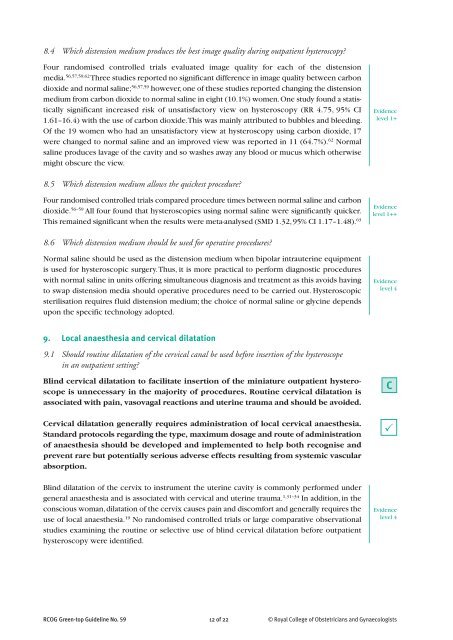Best Practice in Outpatient Hysteroscopy - British Society for ...
Best Practice in Outpatient Hysteroscopy - British Society for ...
Best Practice in Outpatient Hysteroscopy - British Society for ...
Create successful ePaper yourself
Turn your PDF publications into a flip-book with our unique Google optimized e-Paper software.
8.4 Which distension medium produces the best image quality dur<strong>in</strong>g outpatient hysteroscopy?<br />
Four randomised controlled trials evaluated image quality <strong>for</strong> each of the distension<br />
media. 56,57,59,62 Three studies reported no significant difference <strong>in</strong> image quality between carbon<br />
dioxide and normal sal<strong>in</strong>e; 56,57,59 however,one of these studies reported chang<strong>in</strong>g the distension<br />
medium from carbon dioxide to normal sal<strong>in</strong>e <strong>in</strong> eight (10.1%) women.One study found a statistically<br />
significant <strong>in</strong>creased risk of unsatisfactory view on hysteroscopy (RR 4.75, 95% CI<br />
1.61–16.4) with the use of carbon dioxide.This was ma<strong>in</strong>ly attributed to bubbles and bleed<strong>in</strong>g.<br />
Of the 19 women who had an unsatisfactory view at hysteroscopy us<strong>in</strong>g carbon dioxide, 17<br />
were changed to normal sal<strong>in</strong>e and an improved view was reported <strong>in</strong> 11 (64.7%). 62 Normal<br />
sal<strong>in</strong>e produces lavage of the cavity and so washes away any blood or mucus which otherwise<br />
might obscure the view.<br />
8.5 Which distension medium allows the quickest procedure?<br />
Four randomised controlled trials compared procedure times between normal sal<strong>in</strong>e and carbon<br />
dioxide. 56–59 All four found that hysteroscopies us<strong>in</strong>g normal sal<strong>in</strong>e were significantly quicker.<br />
This rema<strong>in</strong>ed significant when the results were meta-analysed (SMD 1.32,95% CI 1.17–1.48). 63<br />
8.6 Which distension medium should be used <strong>for</strong> operative procedures?<br />
Normal sal<strong>in</strong>e should be used as the distension medium when bipolar <strong>in</strong>trauter<strong>in</strong>e equipment<br />
is used <strong>for</strong> hysteroscopic surgery.Thus, it is more practical to per<strong>for</strong>m diagnostic procedures<br />
with normal sal<strong>in</strong>e <strong>in</strong> units offer<strong>in</strong>g simultaneous diagnosis and treatment as this avoids hav<strong>in</strong>g<br />
to swap distension media should operative procedures need to be carried out. Hysteroscopic<br />
sterilisation requires fluid distension medium; the choice of normal sal<strong>in</strong>e or glyc<strong>in</strong>e depends<br />
upon the specific technology adopted.<br />
9. Local anaesthesia and cervical dilatation<br />
9.1 Should rout<strong>in</strong>e dilatation of the cervical canal be used be<strong>for</strong>e <strong>in</strong>sertion of the hysteroscope<br />
<strong>in</strong> an outpatient sett<strong>in</strong>g?<br />
Bl<strong>in</strong>d cervical dilatation to facilitate <strong>in</strong>sertion of the m<strong>in</strong>iature outpatient hysteroscope<br />
is unnecessary <strong>in</strong> the majority of procedures. Rout<strong>in</strong>e cervical dilatation is<br />
associated with pa<strong>in</strong>, vasovagal reactions and uter<strong>in</strong>e trauma and should be avoided.<br />
Cervical dilatation generally requires adm<strong>in</strong>istration of local cervical anaesthesia.<br />
Standard protocols regard<strong>in</strong>g the type, maximum dosage and route of adm<strong>in</strong>istration<br />
of anaesthesia should be developed and implemented to help both recognise and<br />
prevent rare but potentially serious adverse effects result<strong>in</strong>g from systemic vascular<br />
absorption.<br />
Bl<strong>in</strong>d dilatation of the cervix to <strong>in</strong>strument the uter<strong>in</strong>e cavity is commonly per<strong>for</strong>med under<br />
general anaesthesia and is associated with cervical and uter<strong>in</strong>e trauma. 1,31–34 In addition, <strong>in</strong> the<br />
conscious woman,dilatation of the cervix causes pa<strong>in</strong> and discom<strong>for</strong>t and generally requires the<br />
use of local anaesthesia. 19 No randomised controlled trials or large comparative observational<br />
studies exam<strong>in</strong><strong>in</strong>g the rout<strong>in</strong>e or selective use of bl<strong>in</strong>d cervical dilatation be<strong>for</strong>e outpatient<br />
hysteroscopy were identified.<br />
Evidence<br />
level 1+<br />
Evidence<br />
level 1++<br />
Evidence<br />
level 4<br />
RCOG Green-top Guidel<strong>in</strong>e No. 59 12 of 22 © Royal College of Obstetricians and Gynaecologists<br />
C<br />
<br />
Evidence<br />
level 4



